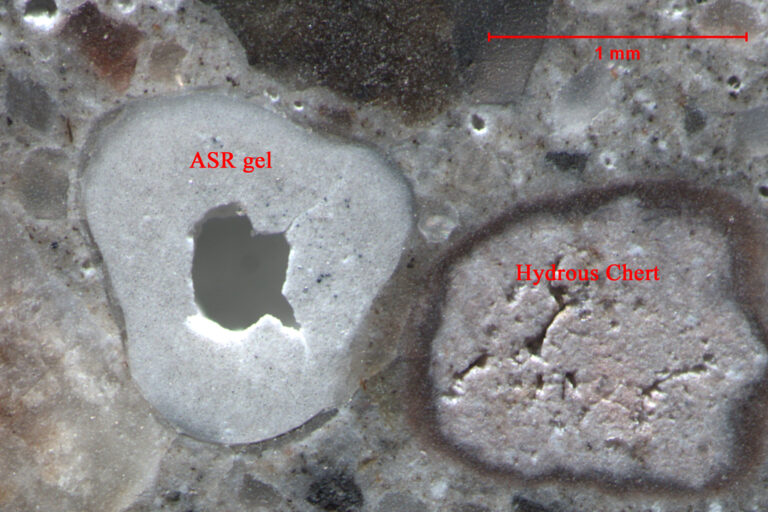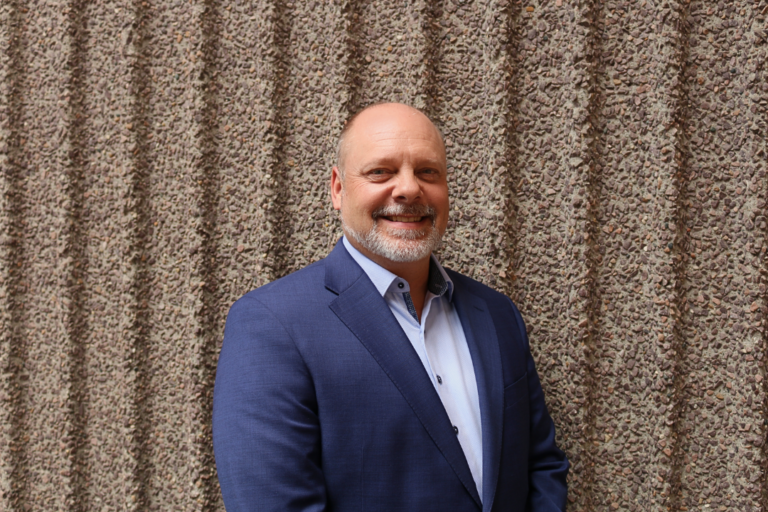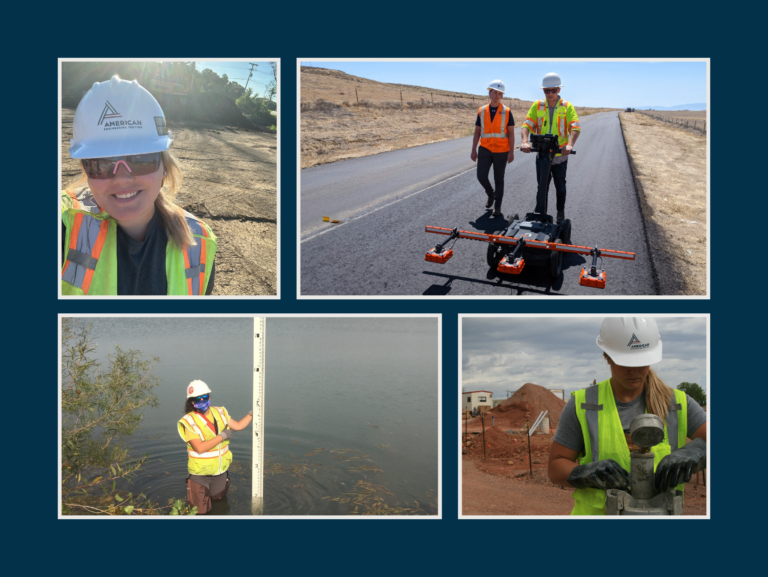What is Alkali-silica reactivity?
Alkali-silica reactivity (ASR) remains a major durability issue affecting concrete structures, including heavy civil infrastructure, such as dams, bridges, pavements, and nuclear power plants — despite over 70 years of investigations. (See references [1]–[4] below.)
How does ASR impact concrete?
ASR is often referred to as the concrete “cancer” because of its devastating implications and the complexity of the mechanism.
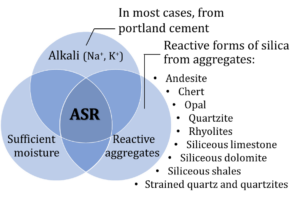
According to the American Concrete Institute (ACI) glossary (CT-21 – Concrete Terminology [5]), ASR is a chemical reaction in either mortar or concrete between alkalies (sodium Na+ and potassium K+) from portland cement or other sources and certain constituents of some aggregates.
The figure to the right illustrates the factors that contribute to the development of ASR in concrete.
ASR damage not only affects the functionality of a structure but also its structural performance. The figure below shows a simplified model of the ASR mechanism and how it damages and deteriorates concrete over time. In addition, the cracking that often results from ASR can also contribute to further deterioration mechanisms, such as freeze-thaw damage and corrosion [6], [7].
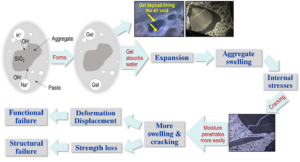
Important Facts about ASR in concrete
There is a lot we know about ASR and it’s effects on concrete.
- It’s a slow reaction, occurring years or decades after construction [8]
- The reaction creates expansive products that cause cracking
- The reaction has been reported in 60 countries (as of 2017) [9]
- In the US, as of 2003 about 40 States have reported ASR [9]
- In France, 500 bridges and 5 dams are affected [10]
- Damage due to ASR leads to safety concerns, especially in nuclear facilities and dams [11]–[13]
Identifying or determining the extent of ASR can be a complicated matter. For example, not all reactive aggregates react the same way or at the same rate, so laboratory testing may show false positives or negatives [14]. In existing structures, it is difficult to evaluate the extent of the reaction at any point in time. It’s also hard to deduce how much more the structure may expand as the reaction continues [6], [11].
Repair and replacement of ASR-affected structures has significant economic impact. Some examples of ASR-damaged infrastructure and the resulting price tags for repair/replacement are noted below.
-
- Channel Island Air National Guard Base – US$ 16 million for apron replacement [16]
- Denver International Airport – US$ 10 to 30 million per runway in repair costs [17]
- Mactaquac Generation Station – US$ 6-7 million/year to reduce impact [15]
(In this case, the aggregate was originally reported as non-reactive, but ASR was observed later on.) - Munna Point Bridge, Queensland – over $ 5 million in repair and maintenance of piles [18]
The efficiency of mitigation measures can be controversial:
-
- Chemical treatments in existing structures, such as lithium nitrate impregnation, may not penetrate deep enough to control the reaction [6].
- The use of sealants and crack filling are not always capable of preventing the penetration of moisture into the concrete [6].
- Saw cutting sections of the affected concrete does not mitigate the reaction, it is just a means to accommodate the expansion. In addition, depending on the structure, saw cutting is not always a viable alternative [6].
- Use of physical restraint or confinement can reduce the deleterious expansion but impacts the structural response [11], [19].
ASR Evaluation and Testing Methodologies
One of the challenges in the detection of reactive aggregates and the identification of effective ASR prevention strategies is that it takes years, sometimes, decades for ASR to manifest itself, so laboratory tests accelerate the reaction by providing severe exposure conditions and by modifying the concrete mixture.
There are four common standard test methods used to assess ASR in the U.S. The major differences among these methods are related to the size of the aggregates in a mixture, the testing temperature, the storage conditions, and the test duration, varying from 16 days to up 2 years.
- ASTM C1293 – Standard Test Method for Determination of Length Change of Concrete Due to Alkali-Silica Reaction
- AASHTO T 380 – Standard Method of Test for Potential Alkali Reactivity of ASR Mitigation Measures (Miniature Concrete Prism Test, MCPT)
- ASTM C1260 – Standard Test Method for Potential Alkali Reactivity of Aggregates (Mortar-Bar Method
- ASTM C1567 – Standard Test Method for Determining the Potential Alkali-Silica Reactivity of Combinations of Cementitious Materials and Aggregate (Accelerated Mortar-Bar Method)
Table 1 – Summary of Most Used Test Methods in the United States
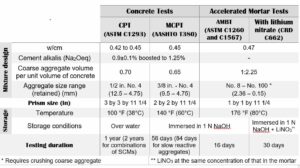
In addition to the test methods, there is one guide – ASTM C295/C295M – Standard Guide for Petrographic Examination of Aggregates for Concrete – that assesses the aggregates for their potential reactive phases and also two practices – AASHTO R 80 and ASTM C1778, Standard Practice for Determining the Reactivity of Concrete Aggregates and Selecting Appropriate Measures for Preventing Deleterious Expansion in New Concrete Construction. These standard practices provide recommendations for identifying the potential for deleterious ASR and offer guidance for selecting appropriate preventive measures to minimize the risk of deleterious reaction. These recommendations are based on both prescriptive or performance approaches and consider different levels of acceptable risk.
It is Possible to Prevent ASR?
Through careful selection of the materials used in the concrete mix, ASR can be avoided [6], [14]. A qualified materials testing lab will guide you in the selection of materials that meet your project specifications, including:
-
- Non-reactive aggregates
- Low-alkali cements
- Sufficient supplementary cementitious materials (such as, fly ash, slag, silica fume) or lithium nitrate
The AET St. Paul office includes one of the largest construction materials testing laboratories in the US — conducting construction materials performance evaluations for engineering projects across the nation and around the world. The AET St. Paul laboratory is AASHTO accredited and is a USACE validated Laboratory. Our AASHTO accreditation list is extensive and includes all the test methods to evaluate alkali silica reactivity.
Can ASR, the concrete “cancer”, be cured?
When ASR is suspected, we team with our clients to determine the best mitigation measures, such as the use of supplementary cementitious materials and lithium nitrate, as well as to determine its optimal dosage to prevent ASR, so that the project specification requirements are met. Before construction, AET may perform mortar and concrete expansion tests to evaluate the reactivity of a specific aggregate or the efficiency of a preventative measure.
For existing structures, our expert concrete petrographers, and forensic chemists leverage their decades of experience using thin-section petrography, scanning electron microscope, and X-ray diffraction to evaluate structures exhibiting ASR or determining the potential for ASR to develop in the future.
AET provides a holistic approach regarding ASR, beyond testing. We help our clients with the selection of a sound solution to potential or existing ASR issues.
Jussara Tanesi, P.hD., FACI, is highly respected for her expertise in concrete materials research, concrete specifications, materials characterization, evaluation of new materials and testing, standardization, and concrete durability and sustainability. Ms. Tanesi, a member of the AET Concrete Materials Laboratory team, can be reached at jtanesi@amengtest.com.
Cited References
[1] T. E. Stanton, “Expansion of concrete through reaction between cement and aggregate,” Proc. Am. Soc. Civ. Eng., vol. 66, no. 10, 1940.
[2] J. McGowan and H. Vivian, “Studies in cement-aggregate reaction: correlation between crack development and expansion of mortars,” Aust. J. Appl. Sci., vol. 3, pp. 228–232, 1952.
[3] P. Wedding and D. Stark, “Alkali-Silica Reactivity: Some Reconsiderations,” Cem. Concr. Aggregates, vol. 2, no. 2, p. 92, 1980, doi: 10.1520/CCA10189J.
[4] R. Helmuth, D. Stark, and S. Diamond, “Alkali-Silica: An Overview of Research. SHRP-C-342.” Strategic Highway Research Program, 1993.
[5] American Concrete Institute, “ACI CT-21: Concrete Terminology.” 2021.
[6] B. Fournier, A. Bérubé, K. Folliard, and M. Thomas, “Report on the Diagnosis, Prognosis, and Mitigation of Alkali-Silica Reaction (ASR) in Transportation Structures. FHWA-HIF-09-004.” Federal Highway Administration, 2010.
[7] I. Fernandes and M. A. T. M. Broekmans, “Alkali–Silica Reactions: An Overview. Part I,” Metallogr. Microstruct. Anal., vol. 2, no. 4, pp. 257–267, Aug. 2013, doi: 10.1007/s13632-013-0085-5.
[8] P. K. Mehta and P. Monteiro, Concrete: microstructure, properties, and materials. McGraw-Hill Education, 2014.
[9] I. Sims and A. Poole, Alkali-Aggregate Reaction in Concrete: A World Review. 2017.
[10] R. Martin, C. Bazin, and F. Toutlemonde, “Alkali aggregate reaction and delayed ettringite formation: common features and differences,” 2012.
[11] N. W. Hayes et al., “Monitoring Alkali-Silica Reaction Significance in Nuclear Concrete Structural Members,” J. Adv. Concr. Technol., vol. 16, no. 4, pp. 179–190, Apr. 2018, doi: 10.3151/jact.16.179.
[12] C. Acevedo and M. Serrato, “Determining the effects of radiation on aging concrete structures of nuclear reactors,” in WM2010 Conference, 2010, p. vol. 7. No. 11.
[13] K. William, Y. Xi, and D. Naus, “A review of the effects of radiation on microstructure and properties of concretes used in Nuclear Power Plants,” 2013.
[14] M. Thomas, B. Fournier, and K. Folliard, “ALKALI-AGGREGATE REACTIVITY (AAR) FACTS BOOK.” Federal Highway Administration, p. 224, 2013.
[15] E. Moffatt, M. Thomas, S. Hayman, B. Fournier, J. Ideker, and J. Fletcher, “Remediation strategies intended for the reconstruction of the ASR-induced Mactaquac dam,” 2016.
[16] U.S. Army Corps of Engineers, Naval Facilities Engineering Service Center, and A. F. C. E. S. Agency, “REPORT ON ALKALI-AGGREGATE PROBLEMS ON PORTLAND CEMENT CONCRETE AIRFIELD PAVEMENTS.”
[17] Associated Press, “Rebuild planned for 15 years old Detroit runway,” The Washington Times, 2015.
[18] C. Dowding, “Seeking a Cancer Cure for Munna Point Bridge,” Eng. Public Work., vol. June, 2017.
[19] A. Abd-Elssamd, Z. J. Ma, Y. Le Pape, N. W. Hayes, and M. Guimaraes, “Effect of Alkali-Silica Reaction Expansion Rate and Confinement on Concrete Degradation,” ACI Mater. J., vol. 117, no. 1, Jan. 2020, doi: 10.14359/51720294.
